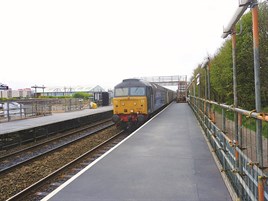More capacity was available to help with evening trains, but the outlook was not promising as the DfT said that a replacement road bridge would not be available for many months. Then came an offer of help…
Direct Rail Services is a freight company based in Cumbria. It has strong links with the Cumbrian Coast through running trains to Sellafield, where the company was initially set up. Staff live on the coast, and the floods would have affected them and their friends.
Managing Director Neil McNicholas told RAIL that as soon as he was aware of the devastation he was on the phone to Northern, seeing what could be done. Initially he planned to run trains to meet buses that would serve the affected stations.
This would allow capacity to be reduced on Northern’s trains. But then he had a better idea: what about running additional trains?
At the same time, Network Rail Route Director Jo Kaye quickly announced that a new station was to be built north of the river, about one mile from Workington station.
After rapid consultation with the local Allerdale Borough Council, work started on the site on November 24. Normal planning permission requirements were waived, and NR agreed a two-year lease deal with the council.
The station will never win awards for its architectural beauty, with its scaffolding and simplistic design, but for usefulness it could clean up. It cost £300,000, and was approved by NR Finance Director Patrick Butcher and Operations Director Robin Gisby, which allowed the company’s lengthy approvals panel and process to be cleared quickly. The location was determined using the company’s helicopter that was already in the area, giving aerial assessments of how badly the floods affected the railway.
On November 30, the station opened. By then, DRS had already run some shuttle trains between Maryport and Workington.
As the local operator, Northern would market the trains but only its safety case does not include locomotives and stock, which were to be used on the trains. However, Network Rail and the Office of Rail Regulation changed this quickly and Northern was able to run the trains. DRS runs them on its safety case - technically they are charter trains.
Says Warnes: “We ran the first train on November 27. We did not have locomotive-hauled trains on our access agreement, but the ORR helped. Some consultation periods that were needed normally took four weeks, but they said they would do that later. It was a showcase of the industry pulling together when it had to.”
But why DRS? “I had been on the train before when there was a community event in the North West, so I knew the stock and got to know DRS then.”
Two locomotives top and tail four coaches, running a roughly hourly service in each direction between Workington and Maryport. The coaches are three DRS Mk 3 Open Firsts (FO) and Mk 2D brake standard open (BSO) hired from West Coast Railway Company.
Both locomotives are left running to allow for a quick turnaround but because the train is not through wired it means that the rear locomotive needs to be manned at all times. Also, one locomotive had to be fitted with electric train heating (ETH) to power the systems on board the coaches. If this locomotive was switched off, then people could not get off the train because the central door locking (CDL), which is powered by the ETH, would not work.
Says Warnes: “It is a Northern service under our contract. We hire trains and the crews from DRS.” He says there wasn’t the opportunity to change the existing timetable to be more accommodating of the shuttle. Nor did the infrastructure on the Coast help, as it is full of single sections with long headways. So it ran in the gaps that were available.
Warnes says locomotive-hauled trains were the only option. “There was no more stock available and the DfT asked us to come up with an idea.” As a result, the DfT is funding Northern’s hire of the train and covers all the costs.
















Login to comment
Comments
No comments have been made yet.